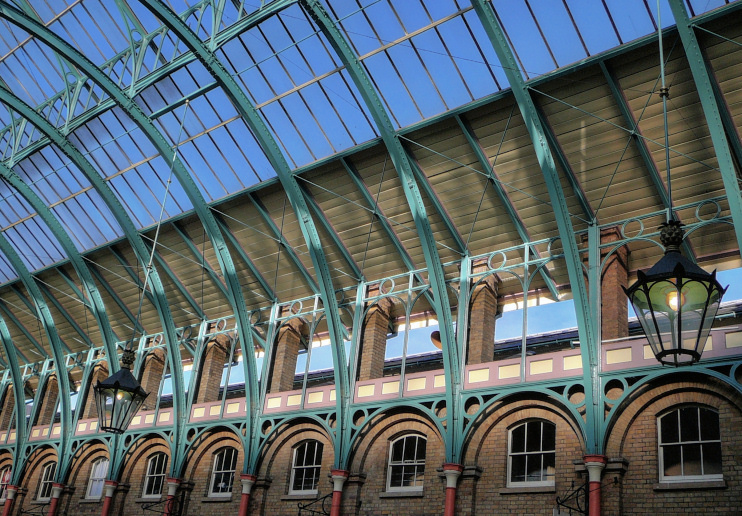Covent Garden
Covent Garden, Westminster/Camden
A thriving commercial zone centred on a former wholesale market east of Soho and south of Bloomsbury

It is generally asserted that the name is a corruption of ‘convent garden’ but in fact it is almost certain that ‘covent garden’ was the original version (as the word ‘convent’ is a Latinised form of the Anglo-Norman covent and did not appear in the English language until the mid-16th century) and that the name has always been rendered this way, at least in spoken form.
The Romans did no more than pass through here but Saxons lived in the area after they established the settlement of Lundenwic, which flourished from ad600. After 900, Viking attacks prompted the Saxons to move back within the walls of the City of London and there was little activity in this locality until the abbot and convent of the Benedictine abbey of St Peter, Westminster, established a 40-acre garden here in the 13th century.
Following the dissolution of the monasteries, the Bedford family acquired the land, which remained in agricultural use until the fourth Earl of Bedford obtained a licence from the Crown in 1630 to lay out an estate here. This represented quite a coup, as requests for such licences were generally being refused at this time.
Inigo Jones laid out a disciplined grid of streets around St Paul’s church and a central piazza partly inspired by the Place des Vosges in Paris, which had been completed in 1605. At first the highest class of citizens made their homes in Covent Garden but the area’s universal popularity proved its undoing. Coffee houses, taverns, theatres and traders of all kinds attracted throngs of Londoners and the aristocrats beat a retreat, leaving ever more dubious characters in their wake.
Even the vice trade was no match for the trade in flowers, fruit and vegetables that dominated Covent Garden from the 18th century. The market buildings of the present-day piazza were erected in 1830 and roofed over in 1870. Neighbouring slums were progressively cleared and replaced by ‘model’ housing for the working classes.
To escape the traffic congestion of post-war London, the wholesale market relocated to Nine Elms in 1973. The Greater London Council planned to demolish the market buildings but an exemplary community campaign brought a change of heart that resulted in their refurbishment in 1980 as a retail shopping complex (shown in the photograph at the top of this article).
The redevelopment succeeded beyond the wildest dreams of its proponents and Covent Garden is now one of London’s busiest destinations for shopping trips, dining out and general entertainment.
The residential population has recovered as run-down old homes have been modernised, although the area retains a broad social mix, with many people still renting from the council or housing associations. Small businesses have been drawn in, especially those operating in new media sectors.
Most of central Covent Garden is nowadays owned by Shaftesbury Capital. The historical aspects of the main buildings of Covent Garden’s piazza are safeguarded by the Covent Garden Area Trust.
The poet Andrew Marvell lived on Maiden Lane, where the artist JMW Turner was born above his father’s barber’s shop in 1775.
James Boswell wrote The Life of Johnson while living on Great Queen Street, which was also home to the dramatist Richard Brinsley Sheridan and the poet William Blake.
Among the many films that have used Covent Garden as a backdrop, the most distinguished are 1964’s My Fair Lady and 1972’s Frenzy. The latter evocatively captures the fruit and vegetable market in its final days – a world away from the scene today.
